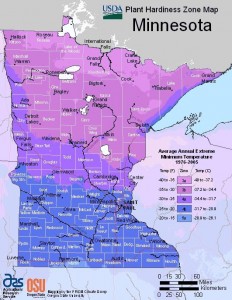Landscape Design and Landscape Construction MN
For years, Arbor Day Foundation members have said the climate conditions for tree planting were changing. According to the latest release of new plant hardiness zones from the U.S. Department of Agriculture, they’re right. The official map was long overdue for an overhaul. Those who had relied on the old map found it to be severely out of date. The new map more accurately reflects conditions in backyards and neighborhoods across the country.
What are Hardiness Zones?
If you’re new to gardening and landscaping, you may be wondering what all the fuss is with these zones, and how to find out which zone you are planting in.
A hardiness zone documents the average lowest winter temperature in a given region. This is key information for growing, as it determines what level of cold-related stress a tree can handle.
Basically, plant hardiness zones are a guide to help you know which plants will grow where you live, so you don’t plant things that will soon die just because they can’t manage your region’s temperatures. Plants vary in the temperature extremes they can endure.
The Plant Hardiness Zones divide the United States and Canada into 11 areas based on a 10 degree Fahrenheit difference in the average annual minimum temperature. (The United States falls within Zones 2 through 10). For example, the lowest average temperature in Zone 2 is -50 to -40 degrees Fahrenheit, while the minimum average temperature in zone 10 is +30 to +40 degrees Fahrenheit.
Suggested hardiness zones have been indicated for all trees and perennials. If a range of zones, for example, zones 4-9, is indicated, the tree or perennial is known to be hardy in zones 4, 5, 6, 7, 8, and 9. Suitable hardiness means a plant can be expected to grow in the zone’s temperature extremes, as determined by the lowest average annual temperature.
Keep in mind that local variations such as moisture, soil, winds, and other conditions might affect the viability of individual plants.
Note: If the map that displays your zone appears inaccurate, you may be in a microclimate.
Some zip codes are in small areas that are warmer or cooler than the surrounding area. These areas, called microclimates, are often associated with urbanization or steep elevation changes, and many are too small to show on our map.
If it looks on the map like your zip code should be in a different hardiness zone than the one we provide for you, your zip code is probably in a microclimate that is too small to represent on the map.
Microclimates occur in most large cities due to the urbanization effect that buildings bring about. In addition, regions of the country with bodies of water or mountains may contain “pockets.” These climatic pockets mirror warmer or cooler zones than the surrounding region.
When we plant trees in our yard, they immediately go to work for us. The shade provided by trees during hot summer days not only makes life more comfortable, it also reduces the energy consumed through air conditioning by as much as 40 percent. In winter time, well-placed trees can block bitter winds, resulting in reduced energy use from heating. And, a parking lot with 50 percent shading can eliminate one ton of emissions per day, while extending the life of the pavement.
When households demand less energy, we save precious resources and reduce the greenhouse gas emissions that contribute to climate change because utility companies save energy during periods of peak demand. When mature trees absorb carbon dioxide in urban areas, harmful pollutants are removed from the atmosphere and are naturally regenerated.
In addition to its positive environmental impacts, a healthy lawn can also make a home more marketable, and in this tough housing market, a well-cared-for lawn can make or break a sale.
Minnesota Landscape Design Contractor
Many homeowners are excited to explore new species of tree previously untenable in their region when they are deciding on new landscaping design ideas to spruce up their yards. You may want to ask a professional Landscaping Company about which trees to plant in your area.

